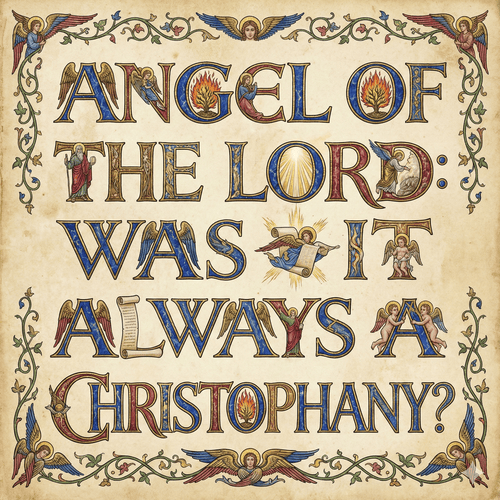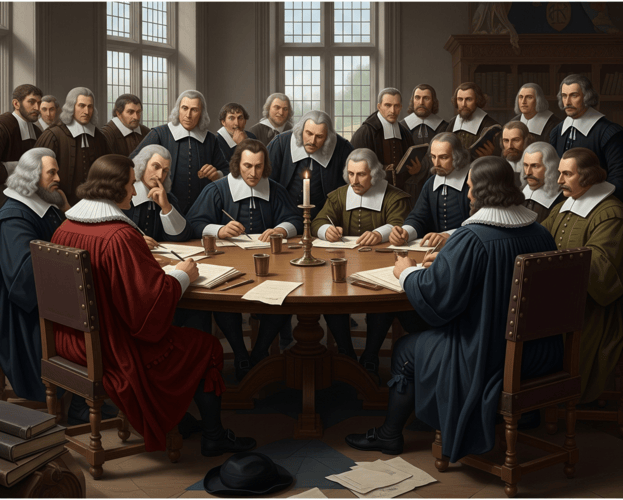The Westminster Confession: Why This Document Still Matters
Even as England burned during the civil war in the 1640s, 151 of the era’s brightest theologians quietly gathered in Westminster Abbey’s Jerusalem Chamber to craft what would become one of Christianity’s most enduring and influential theological statements. The Westminster Confession of Faith wasn’t born in ivory towers or secluded monasteries—it emerged from the chaos of political upheaval, religious division, and national crisis.
Today, nearly four centuries later, this remarkable document continues to serve as the constitutional foundation for Presbyterian churches worldwide and influences Reformed theology across denominational lines. But why does a 17th-century confession still matter in our digital age?
BORN FROM NATIONAL CRISIS
The Westminster Confession didn’t emerge in a vacuum. By the early 1640s, England was tearing itself apart. King Charles I’s attempts to impose Anglican liturgy on Presbyterian Scotland had backfired spectacularly, triggering conflicts that would ultimately cost him his crown—and his head. Parliament, locked in struggle with the monarchy, desperately needed allies.
Enter the Scots. In 1643, the English Parliament signed the Solemn League and Covenant with Scottish Covenanters, promising to reform religion “according to the Word of God” in exchange for military support. This wasn’t just political manoeuvring—it created urgent pressure for new confessional standards that could unify the fractured religious landscape across England, Scotland, and Ireland.
The existing Thirty-Nine Articles of the Church of England were insufficient for this task. What was needed was something more comprehensive, more Reformed, and more biblically grounded. Parliament’s solution was to convene an assembly of divines who could hammer out the theological framework for a reformed national church.
THE ASSEMBLY: SCHOLARSHIP MEETS POLITICS
On July 1, 1643, the Westminster Assembly convened with an impressive roster: 121 clergy and 30 laymen, representing the finest theological minds of their generation. While officially summoned by Parliament rather than church authorities, these weren’t mere political appointees. Men like William Twisse (the Assembly’s Moderator), Stephen Marshall, and Thomas Goodwin were serious scholars who brought decades of pastoral and academic experience to their work.
The Assembly’s composition reflected England’s religious diversity while maintaining a Reformed theological centre. Though it included Episcopalians, Presbyterians, and Independents (Congregationalists), most members shared Puritan convictions and Reformed doctrinal commitments. Scottish commissioners, officially present only as observers, wielded considerable influence through their theological expertise and political leverage.
Their working method was rigorous to the point of obsession. Over five years, they met 1,163 times, subjecting every phrase to intense scrutiny. Nothing made it into the final document without extensive biblical support—every major assertion required proof texts from Scripture. This wasn’t theology by committee in the worst sense; it was collaborative scholarship at its finest.
A CONFESSION TAKES SHAPE
The resulting Westminster Confession of Faith spans 33 chapters, systematically addressing every major Christian doctrine from Scripture’s authority to the final judgement. But this wasn’t merely an academic exercise in systematic theology. The divines crafted their work with pastoral concerns in mind, creating a document that could serve both scholarly study and congregational instruction.
The Confession’s theological distinctives reflect its Reformed heritage. It articulates classic Calvinist doctrines—salvation by grace alone, divine sovereignty, predestination—with remarkable precision and biblical grounding. Yet it avoids the sterile scholasticism that would plague later Reformed orthodoxy, maintaining a warmth and practicality that speaks to Christian experience.
Alongside the Confession, the Assembly produced the Larger and Shorter Catechisms for educational purposes, a Directory for Public Worship, and a Form of Presbyterian Church Government. Together, these documents provided a complete blueprint for Reformed church life that could be implemented from Scotland’s highlands to England’s parishes.
ENDURING IMPACT ACROSS CENTURIES
The Confession’s influence was immediate and lasting. The Scottish Kirk adopted it in 1647 and still maintains it as their doctrinal standard today. Though English political changes limited its official role there, the document spread globally through Presbyterian missions and immigration.
In America, the Confession became foundational to Presbyterian identity. Both the Presbyterian Church (USA) and the Presbyterian Church in America continue to require ministerial subscription to its doctrines. The Orthodox Presbyterian Church maintains it without qualification. Even Baptist churches found value in its systematic approach—the 1689 London Baptist Confession follows the Westminster structure almost exactly, adapting only sections on baptism and church government.
Educationally, the Confession served as a systematic theology textbook for generations of ministers. Seminary curricula across denominations have used it to teach doctrinal precision and biblical interpretation. The accompanying catechisms became standard tools for Christian education, with countless believers learning theology through their memorable question-and-answer format.
ACCESSING THIS LIVING DOCUMENT
Today’s readers need not hunt through library stacks to engage the Westminster Confession. Numerous websites offer complete texts with searchable Scripture references. The Westminster Confession website provides free access alongside helpful study materials. Reformed theology sites and mobile apps make the documents portable for contemporary study.
Free Presbyterian Church of Scotland provides the Westminster Confession as adopted in 1647 by the Church of Scotland, with Scripture proofs.
Link: Westminster Confession of Faith
Presbyterian Church in America (PCA) provides the Westminster Confession as adopted in 1973, based on the 1788 American revisions, with two minor exceptions: deletion of strictures against marrying a wife’s kindred (Chapter 24, Section 4) and the reference to the Pope as the Antichrist (Chapter 25, Section 6).
Link: Westminster Confession of Faith, PCA
WHY IT STILL MATTERS
In our fragmented religious landscape, the Westminster Confession offers something increasingly rare: comprehensive, biblically-grounded theological consensus achieved through rigorous scholarly collaboration. It demonstrates serious Christians can engage difficult doctrinal questions without sacrificing either intellectual integrity or pastoral sensitivity.
For contemporary believers, whether Presbyterian or not, the Confession provides a masterclass in biblical theology. Its systematic approach to Scripture, careful reasoning, and practical applications offer tools for navigating modern theological challenges. This 380-year-old document continues to provide clarity, depth, and wisdom for Christians serious about their faith.
The Westminster divines created more than a historical curiosity—they crafted a living document that continues to shape Christian understanding across the globe. Their legacy reminds us the best theology emerges not from isolated study but from communities of believers wrestling together with God’s Word.
THE WESTMINSTER CONFESSION: RELATED FAQs
What is the Westminster Confession’s relevance today? Contemporary Reformed scholars generally view the Westminster Confession as essential for maintaining biblical hermeneutics in an age of modern critical scholarship. Many argue it provides crucial guidance for interpreting Scripture against claims that deny the historical reliability and divine origin of biblical texts. However, some scholars advocate for careful updates to address modern theological insights while preserving core doctrinal commitments.
- How has the American version of the Westminster Confession been modified from the original? Most American Presbyterian churches use a version that differs from the 1646 original, with changes including softened language on oath-taking, modifications regarding marriage to deceased spouses’ relatives, and removal of references to the pope as antichrist. The most substantial changes involve the role of civil magistrates, reflecting American perspectives on church-state separation. These modifications demonstrate how confessional documents can adapt to new cultural contexts while maintaining theological integrity.
- What criticisms do modern theologians have of the Westminster Confession? Recent criticism has focused particularly on the Confession’s distinction between the visible and invisible church, with some staunch Reformed advocates questioning how this doctrine is expressed. Other contemporary concerns include its approach to biblical interpretation in light of modern scholarship, questions about predestination’s pastoral implications, and debates over whether certain formulations adequately address contemporary theological challenges while remaining faithful to Scripture.
How do Baptist churches use the Westminster Confession despite different views on baptism? Baptist churches worldwide continue subscribing to the 1689 Second London Confession of Faith, which follows Westminster’s structure almost exactly while adapting sections on baptism and church government. This demonstrates the Confession’s theological framework transcends denominational boundaries, with Baptists finding its systematic approach to Scripture and doctrine valuable despite disagreeing on sacramental theology. Modern efforts include updated language versions to make the adapted confession more accessible to contemporary readers.
- Why did the Westminster Assembly include so many biblical proof texts with each doctrine? The Assembly’s extensive use of Scripture citations wasn’t merely academic—it reflected their commitment to “sola scriptura” and provided practical tools for ministers and laypeople to verify doctrinal claims. Each proof text was carefully debated during their 1,163 sessions, ensuring every theological assertion could be defended from biblical grounds. This approach also made the Confession useful for teaching, allowing readers to study both systematic doctrine and its biblical foundations simultaneously.
- How does the Confession’s view of divine providence differ from other Christian traditions? The Westminster Confession emphasises God’s providence and sovereignty as main themes, stating that God governs all events according to his perfect will with nothing happening by chance. This Reformed distinctive contrasts with Arminian traditions that emphasize human free will and Catholic teachings on cooperation with grace. The Confession’s approach provides pastoral comfort in suffering while raising questions about human responsibility that continue to generate theological discussion.
What role does the Westminster Confession play in modern seminary education? The Confession continues serving as a systematic theology textbook in Reformed seminaries worldwide, providing students with a comprehensive framework for understanding biblical doctrine. Many institutions use it to teach theological precision, hermeneutical principles, and the integration of biblical studies with systematic theology. Its opening chapter on Scripture remains foundational not only to the Confession’s theological system but to the entire Protestant tradition, making it essential for understanding Reformed approaches to biblical authority.
THE WESTMINSTER CONFESSION: OUR RELATED POSTS
Editor's Pick

The Throne-Room Vision: Who Did Isaiah See?
The scene is unforgettable: Isaiah stands in the temple, and suddenly the veil between heaven and earth tears open. He [...]

The Angel of the Lord: Can We Be Certain It Was Christ All Along?
Throughout the Old Testament, a mysterious figure appears: the Angel of the LORD. He speaks as God, bears God’s name, [...]
SUPPORT US:
Feel the Holy Spirit's gentle nudge to partner with us?
Donate Online:
Account Name: TRUTHS TO DIE FOR FOUNDATION
Account Number: 10243565459
Bank IFSC: IDFB0043391
Bank Name: IDFC FIRST BANK






